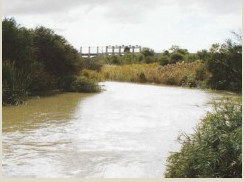Place image

P.W.F. Weyers, a former 'Hawker' (an informal seller of goods). He had lost Cattle in an attack by the Boers during the Anglo-Boer War, was said to have started Darlington Farm in the Jansenville district. He always said that the Boers had shot his Animals in the Bedrogfontein Pass. Weyers settled in Darlington, in the fertile Sundays River Valley in 1905, and planted Fruit Orchards and Vineyards. Later a Hotel, Post Office, Shop, House and several Outbuildings were established on the Farm and later still, they all disappeared under the Waters of Lake Mentz (Darlington Dam) when it was established in 1922.
This huge Dam was created to supply Citrus Farmers further down, in the Sundays River Valley with Irrigation Water for their trees. Weyers left the Farm and it had other owners, among them Dr Reginald Koettlitz. He had accompanied Captain Robert Falcon Scott on his first Antarctic Expedition as senior medical officer. Some say that the doctor was blamed when some of the men of the expedition contracted scurvy and that this led him to come to South Africa, to settle in the Karoo. But, he was not the only famous man to have contact with this Farm and Dam. The first Chairman of the Irrigation Board responsible for the Building of the Dam, was none other than Sir Percy Fitzpatrick, Author of Jock of the Bushveld. And, even the name of the Dam has a good story attached to it. Piet van Niekerk, of Drive Out Magazine (August / September, 2007) wrote: "According to local Legend the then Minister of Land Affairs, Colonel Hendrik Mentz, who had granted Permission for the Building of the Dam, was not exactly a popular fellow, so when it was suggested that the Dam be named after him, some irate person loudly exclaimed: 'Oh, Damn Mentz!' To which he received a polite reply: 'No, no, just Lake Mentz, will do!"'
In the 1990s the 'Lake' was renamed the Darlington Dam. Lake Mentz Construction Commenced in 1918, and was completed in 1924. As had been envisaged from the start, the capacity of the lake became progressively reduced by silting. The wall was raised by 1,5 metres which had the effect of Restoring the Capacity. The accumulation of silt had by 1946, again reduced the Capacity. In 1949, the wall was raised a further 5,8 metres. When the servitude proceedings came before the 'Water Court'; it was agreed that nothing further in the future could be done for Lake Mentz, by way of increasing its storage capacity.
Commenting on the probable life of the Dam, the presiding Judge said: "We are of opinion that, in the conflict of admittedly theoretical opinion, the safest figures to adopt on the probabilities is somewhere between 35 and 40 years (from 1949), at which stage (a) the Dam will have ceased to function effectively and (b) the Servitude Area will have been completely silted up". In 1924, Philip Weyer, the main Owner of Land inundated by Lake Mentz, was awarded £27 000 compensation.
Following the raising of the Wall by 5,8 metres in 1949, Weyer's successor, Bertram Henderson, was granted just under £40 000. The event being described at the time in these words: "The action arose as a result of the Raising of the Wall at Lake Mentz, this Case was heard at Somerset East Court House, during November and December. It lasted nearly a Month and Witnesses came from all over the Country. From the judgment it appears the Respondent did well on his Land Valuations, which were substantially sustained by the Court".
Today, Darlington Dam has been incorporated into the Addo Elephant National Park, adding to the attraction for Tourists to the Park.
References
https://www.jansenville.co.za/listing/darlington_dam_lake_mentz